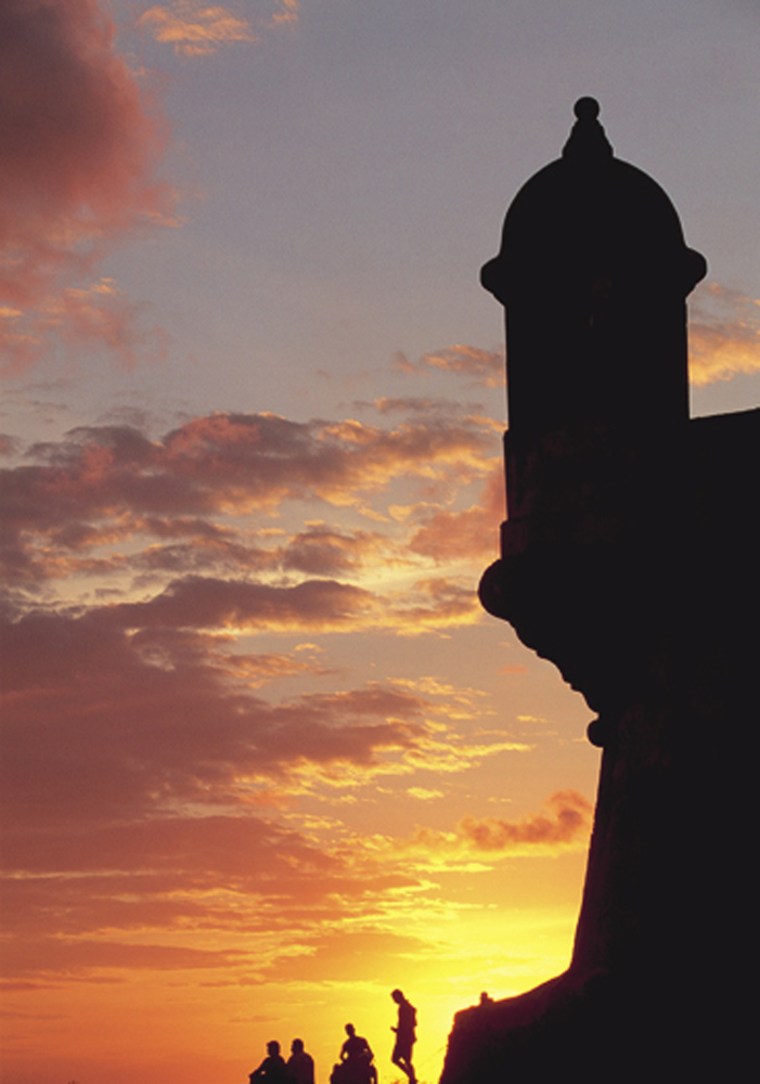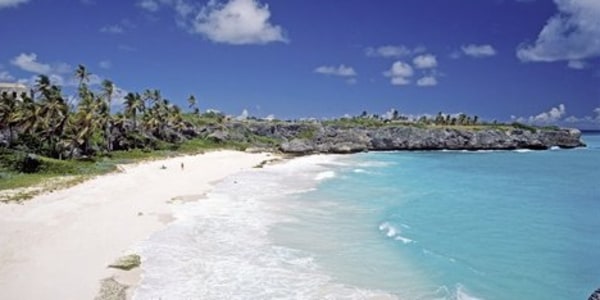Whether you land on Puerto Rico's sunny shores yearning for a day snorkeling in the warm turquoise waters, an afternoon walking amid 500-year-old buildings or an evening dining in the luscious hip restaurants, you've chosen the right place. An all-American destination with a spicy infusion of salsa, Puerto Rico beckons active travelers. From hiking to dining, surfing to museum hopping, you'll find an excellent take on virtually any type of vacation interest.
Pursuing your hobbies is easy, as the well-paved mainland is only 100 miles long and 35 miles wide, making drives a cinch. To reach the farthest ends, you can hop a plane from San Juan to Ponce or Aguadilla, then travel by boat or plane to the outlying islands such as Vieques and Culebra. Most residents speak English and Spanish so it's a snap to find guidance, and your American dollars are at home here, too — but don't be surprised to hear your pennies called centavos or your nickels vellones.
Nature and Adventure
Puerto Rico is rich with natural wonders, including dry forest and rain forest, caves and beaches, mountains and meadows. Puerto Rico has 20 designated forest reserves, and six more are proposed. The largest, at 28,000 acres, is El Yunque, the United States' only tropical rain forest. Families can stroll along nearly flat trails while more athletic hikers can traverse rougher ones. Quite a few lead to thundering waterfalls. The rain forest is home to 50 types of orchids, 150 species of ferns and even four different varieties of forest. While El Yunque has 26 animal species all its own, the Guánica Dry Forest Reserve has yet another 16, plus 48 endangered species. Groomed trails encourage walkers and cyclists to explore Guánica's 600 types of rare plants.
Bird-watchers enjoy the Culebra Natural Wildlife Refuge, where nesting colonies abound within the 1,400 acres, and the Piñones Forest, where a pedestrian-friendly boardwalk through the forest enables spotting of up to 46 families of our feathered friends. Snorkel past the mangroves to view the 36 fish species that call the area home.
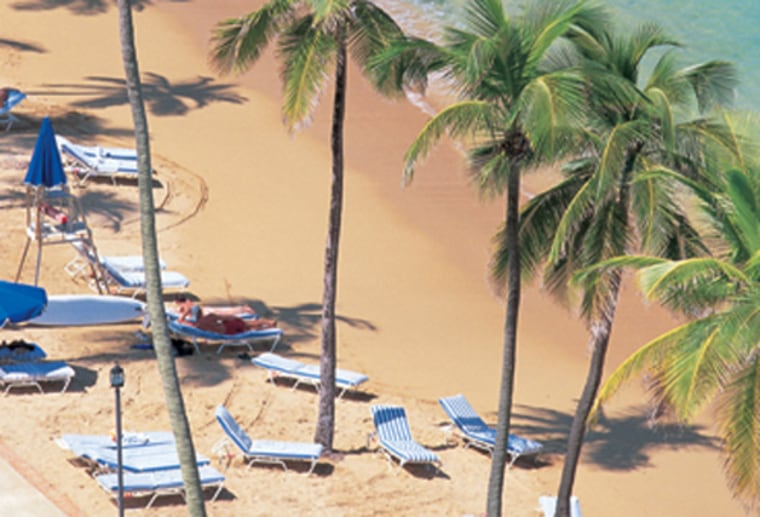
No matter what your passion, plan to find time for one adventure that fits into none of the standard categories: night swimming in a bioluminescent bay. These bodies of water are filled with dinoflagellates, little fire algae that light up and seem to make the water glow. You'll find them in La Parguera, in the south, and in Mosquito Bay, located on the island of Vieques.
Save the resortwear for later as you go caving. The Rio Camuy Cave Park is one of the 10 largest cave systems in the world, and this one has a river thundering right through it – the third-largest underground river on earth. Safely perched in a tram, you'll pass through lush greenery and then spy the Tres Pueblos sinkhole, which reaches down 400 feet. While advanced cave explorers can rappel through rarely seen spots, others can climb to areas with rock carvings etched into stone by Taíno Indians centuries ago.
Beaches and Sports
With 272 miles of coastline, Puerto Rico lures sun worshippers with hundreds of beaches, each of them abutting warm blue-green water, and no two are the same. Most resort hotels provide access to sand and sea along with amenities such as chaise longues, restrooms and restaurants. Public beaches offer other options, from seclusion to water sports.
Slideshow 20 photos
Caribbean way of life
Visitors staying in San Juan's hotels can go right over to Condado Beach, a nearby white-sand wonder. The Sun Capital of Puerto Rico, Luquillo Beach, is a quick 30-mile jaunt from the capital and offers a getaway lined with coconut groves and palm trees. Its translucent water is wheelchair-accessible due to a special area called Mar Sin Barreras, or "sea without barriers." Evening horseback rides down this strip of Atlantic coast add intrigue. Another popular spot is Isla Verde, really a series of strands stretching past resorts, apartments, restaurants and parks on the north coast.
For a more private beach experience, relax at any of Guánica's strands, such as Caña Gorda, known for its palm-frond huts.
Rincón hosted the World Surfing Championships in 1968 and has been a mecca for the sport ever since, with waves often reaching 25 feet. To see one of surfing's top spots, head toward Punta Higuero. During the winter season, humpback whales often swim by.
At Shacks, in Isabela, windsurfers, wave jumpers and kiteboarders enjoy the swells caused by the confluence of the Caribbean and the Atlantic. Trade winds can reach 18 knots in winter.
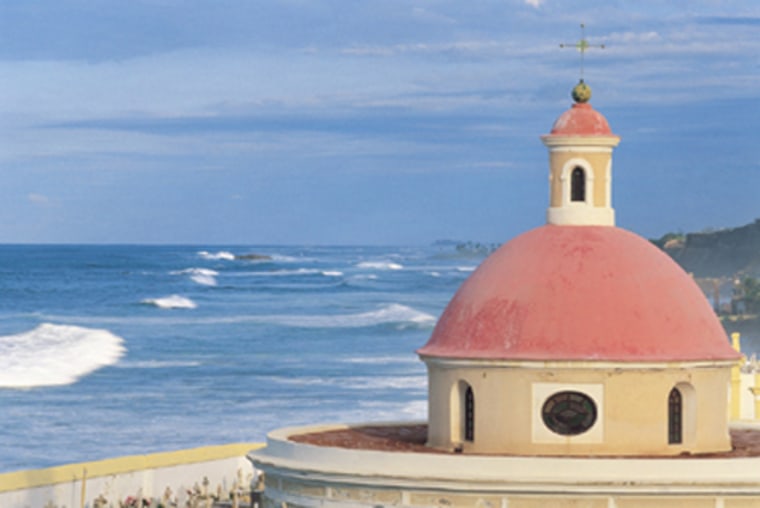
Fishermen head off the coast for their excursions. Anglers can choose shallow water, such as that found near San Juan and Piñones, for tarpon trips; or they can head farther out by powerboat for deep-sea prey. Blue Marlin Alley, near San Juan and Fajardo, is an aptly named destination, especially in August and September, when the numbers of fish swell. Wahoo is plentiful near Humacao, and excursions from several ports, including Rincón and Mayagüez, seek tuna in the Mona Passage. Ask operators at any marina where to go for mahi-mahi, bonito, sailfish, and yellowfin and blackfin tuna.
Surrounded by the Caribbean Sea and the Atlantic Ocean, Puerto Rico offers scuba divers numerous locales in which to seek out underwater wonders. To the west, uninhabited islands off the coast surround two dozen dive sites, among them a "fore reef" formation. Mona Island is called the Galapagos of the Caribbean since its waters are filled with turtles, marlin, dolphins and whales. To the east, Fajardo is the starting point for the Superhero and Palomino walls, boasting small caverns, channels, reefs and mini walls. The southwestern coast is the launching point for a 20-mile-long black-coral wall with steep slopes, and also boasts virgin waters where pirate booty such as coins and muskets are still being discovered.
Fans of land sports need look no further than Puerto Rico, whose resorts spoil guests with 100 tennis courts. The island boasts 24 golf courses, the majority of them championship-level. In fact, three opened in 2004 alone. Golf's top names have designed several of its courses; expect to play on greens engineered by Greg Norman, Gary Player, Robert Trent Jones Sr., George Fazio, Rees Jones, Arthur Hills and Chi Chi Rodrígez. Many are located at resort hotels, while others are public or private courses. These top-notch greens host professional and amateur tournaments. If you're interested in entering, consider the Copa de las Américas and the Puerto Rico Open, among others.
Dining & Nightlife
Puerto Ricans know how to throw a party, and they invite visitors to join right in. Evenings can begin with Latin-fusion cuisine in hip San Juan restaurants, or with traditional cucina criolla meals in traditional dining rooms. The contemporary dinners are most often found within San Juan, many in the SoFo area, and these restaurants attract a young, hip, beautiful crowd who come to sample blends of Latin, French, Asian and even Indian cuisines, all presented in artful ways. For a more authentic Puerto Rican culinary experience, expect plenty of plantains, coriander and cassava, and sample specialties such as asopao, a chicken or shellfish gumbo, and carne guisada puertorriqueño, a beef stew. Outside the capital, look for the Mesones Gastronómicos sign, which proves the restaurants have met the stringent criteria of the Puerto Rico Tourism Company. Thirty-three of these independent restaurants are scattered across the island.
After dessert, wander over to any one of the many sizzling nightclubs or sophisticated lounges featuring salsa, techno or jazz music. If island beats intrigue you, be sure to seek out Puerto Rico's four genres: salsa, bomba, plena and seis. All call upon Puerto Rico's Latin American, Afro-Caribbean and European roots, and most encourage dancing in the most delightful way.
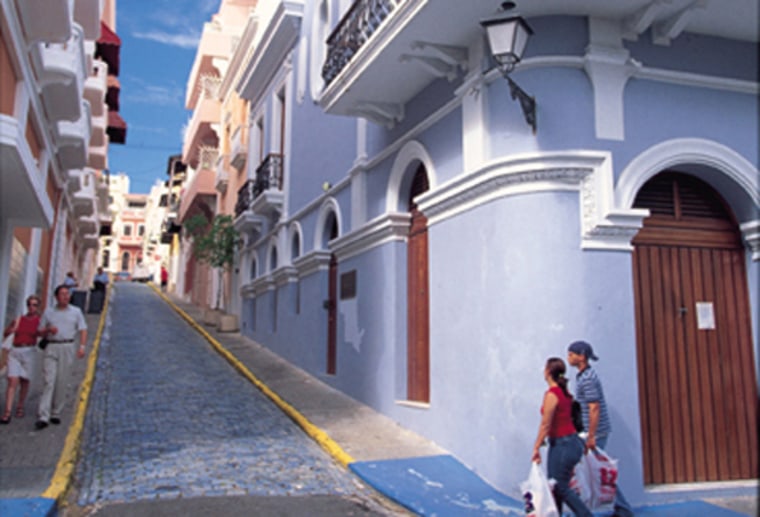
If casinos appeal, there are 20 to choose from, all located within hotels. You can go simple with straightforward slot machines (Puerto Rico has 5,000), or you can try your hand at table games such as blackjack and craps. All told, the island's casinos cover an impressive 18,000 square feet.
History & Culture
Christopher Columbus stopped at Puerto Rico on his second trip to the New World in 1493, and the island's culture hasn't stopped evolving since. Today you'll find buildings from Columbus' day in splendid condition for touring, and you'll be able to stroll from there — along blue-cobblestone streets — to chic modern businesses.
The hub of historic sites is Old San Juan, a seven-square-block center within the contemporary city of San Juan. El Morro is a massive fortress built by the Spanish between 1540 to 1586 to keep Sir Francis Drake's men at bay. Nearby, La Princesa, a former prison, and La Fortaleza, a structure built in 1540 and the governor's home, beckon gawkers. Explorer and governor Ponce de León was the first to live in Casa Blanca, constructed in 1523. Today it houses a museum about de León and one about the Taíno Indians, early inhabitants of the island. Vacationers who have kids along will enjoy a different type of museum altogether: the Children's Museum, in Old San Juan, where hands-on exhibits can keep children entertained for long stretches of time.
With more than 500 historic buildings that have been restored, the city of Ponce, the pearl of Southern Puerto Rico, is a monument to the island's history. In the center of Puerto Rico's second-largest city, visitors will find the Plaza las Delicias, which boasts fountains, gardens and the historic Cathedral of Our Lady of Guadalupe. Be sure to seek out the Fountain of the Lions, honoring eight heroes who saved the city from fire more than two centuries ago. The Ponce Firehouse, whose red and black stripes date back to 1882, is filled with antique fire trucks and is also worth a visit.
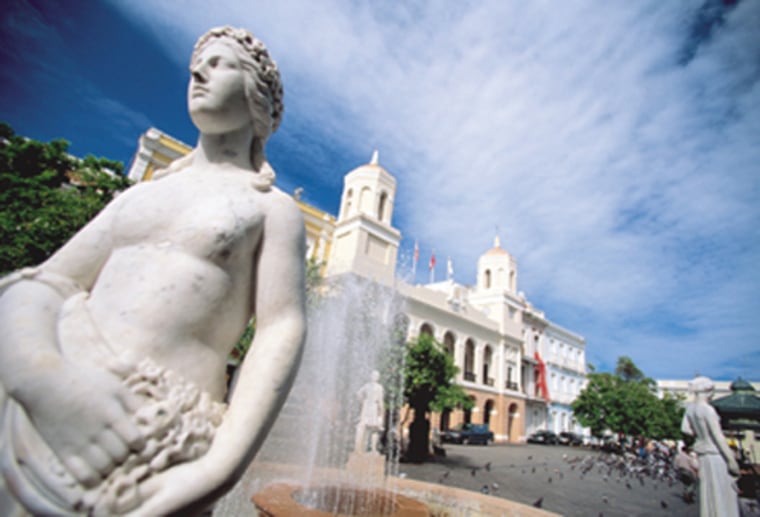
If you make a trip to Las Cabezas de San Juan Nature Preserve, be sure to see El Faro, a restored lighthouse built by the Spanish in the 19th century.
Old San Juan is practically crammed with art museums. Following a $53 million renovation, the Museo de Arte, which is housed in a 1920s hospital and features the works of Puerto Rican artists, is better than ever. In a colonial mansion in the financial district, the Botello Art Gallery is filled with the works of painter, sculptor and santo (religious objects) maker Angel Botello. Another San Juan destination, the Casals Museum, is dedicated to cellist Pablo Casals, who founded the Puerto Rico Symphony Orchestra. Here you'll be able to peruse his medals, manuscripts and photographs. The African Heritage Museum has paintings, musical instruments and masks, and the Museum of Contemporary Art displays modern works by Latin, Caribbean and Puerto Rican artists.
You'll find more than 1,000 paintings and 400 sculptures about 90 minutes away at the Ponce Museum of Art. Featuring the works of European artists including Rubens and Rodin, the museum was designed by Edward Durell Stone – who was also the architect for New York's Museum of Modern Art. Also in Ponce, the Casa Paoli Museum displays art in the birthplace of late opera singer Antonio Paoli; and the Ponce History Museum is known for its looks into the city's past.
Religious art and colonial paintings are featured in the Porta Coeli Museum, which is housed in a 1606 church located in San Germán, the island's second-oldest town.
Every Puerto Rican town has an annual bash honoring its patron saint, and residents also host several other festivals throughout the year, many celebrating agricultural products. Blending the customs of Africans and Spaniards who lived on the island generations ago, many of the festivals feature regional foods, music, dance and games.
The LeLoLai Festival runs throughout the year and offers an amazing immersion experience with Puerto Rican music and dance in authentic settings such as colonial buildings. The National Plantain Festival, in Corozal, is festive with folkloric dances, and adventurous eaters can taste several dishes made with the fruit. Maricao, in coffee country, has parades and exhibits of harvesting tools at the Coffee Harvest Festival. Come June, the Aibonito Flower Festival is a landscaping dream. Shellfish enthusiasts should time their visits to coincide with the crab festival in Maunabo, where they can sample the crustacean prepared several ways.
In June, tribute is paid to cellist Pablo Casals with the Casals Festival in San Juan; visitors can expect to see guest conductors, orchestras and soloists. For music festivals with more of an island fair, consider planning a stay around the Eugenio María Hostos Troubadour Festival in Mayagüez, the Loíza Carnival in Loíza, the World Salsa Congress in San Juan, Puerto Rican Danza week in Old San Juan, the Puerto Rico Heineken Jazz Fest in Hato Rey, or the Güiro and Typical Music Festival in Hatillo.
Spas
No matter how you spend your days on Puerto Rico, you're sure to welcome indulgent spa treatments to help you unwind. You'll find a wide variety of treatments offered by spas ranging in size from tiny (only one treatment room) to huge (an impressive 25 treatment rooms).
Have your skin smoothed with locally grown coffee grounds, tropical fruits or seaweed. The options for massage are just as diverse: Consider a yoga-sage targeting mind, body and soul; a jet-lag massage focusing on the neck and back; a volcanic-stone massage; or side-by-side his-and-her massages. One specialty involves mud made with medicinal herbs and plants grown on the island.
Shopping
In San Juan, the souvenir-happy make a beeline for the Plaza las Américas, a 200-store mecca for the credit-card set. In Old San Juan, walk through the cobblestone streets in the historic district, where Calle del Cristo is a hub of retail activity. Here, stores overflow with jewelry, designer apparel and art. Bargain-hunters will find outlet shops that stock big-name brands such as Polo and Guess. Outside the boutiques, the Plaza de la Darsena and Paseo de la Princesa are chock-full of craft vendors. El Alcázar is an antiques emporium, replete with furniture, crystal, silver and art from across the globe. Additional malls can be found near the airport, in Ponce, in Caguas and in Río Piedras.
Travelers seeking uniquely Puerto Rican products tend to stock up on santos, which are wooden figurines of religious people and scenes; mundilla lace; island-made rum; and vejigantes, papier mâché masks. While you're shopping, be sure to stock up on the robust coffee grown on Puerto Rico.
Undiscovered Puerto Rico
East Coast
Natural wonders and sporting opportunities make Puerto Rico's east coast worth a special trip. Fajardo, known as the Metropolis of the East, is a launching point for Vieques and Culebra (see below) as well as for day sails to small cays. Fajardo itself wows with a 316-acre nature reserve, an 1882 lighthouse and a bioluminescent lagoon, as well as spectacular snorkeling and diving. Río Grande, once full of sugarcane and coffee plantations, is popular for El Yunque, the Caribbean National Forest. Carnival masks are made in Loíza, which also boasts the oldest church in continuous use on the island: 335-year-old Iglesia San Pactricio. You'll find a horseracing track in Canóvanas, a spectacular mile-long beach in Luquillo, and especially good crafts in Las Piedras.
Vieques
The U.S. Navy kept Vieques to itself for several decades. The island is open to the public now, and thanks to its decades-long isolation it's as pristine as it is beautiful, boasting lovely secluded beaches. Boutique hotels dot this largely uninhabited destination, where history buffs can tour a fort whose construction was begun in 1845 but never completed; the Vieques Art and History Museum and the Vieques Archives also offer a fascinating glimpse of the past. The beach at Esperanza is quiet and beautiful, yet is near a conservation gallery and touch pool. Take an electric boat trip to a bioluminescent bay.
Culebra
The last bit of Puerto Rico to change hands from pirates to colonists, Culebra is a pristine little landmass, only seven miles by four miles in size. Flamenco Beach has soft white sand and clear water; it's nearly deserted, yet it does offer basic amenities. Culebra has been a bird refuge since 1909 and is protected by the U.S. Fish and Wildlife Service. The must-see attraction is the National Wildlife Refuge, which covers most of the island plus 23 surrounding ones. Together they encompass subtropical dry forest, mangroves, brush and grasslands. Endangered sea turtles nest here, and the endangered Culebra giant anole, a lizard, originated here. It is estimated that 60,000 sooty terns nest on the Peninsula Flamenco. The island is also a popular spot for snorkeling and fishing.
Caribbean Travel & Life is the magazine for anyone in search of the perfect tropical getaway. Each issue presents expert insider’s advice on where to find the Caribbean’s best beaches and attractions, its finest resorts and spas, liveliest beach bars and activities, and its friendliest people.
